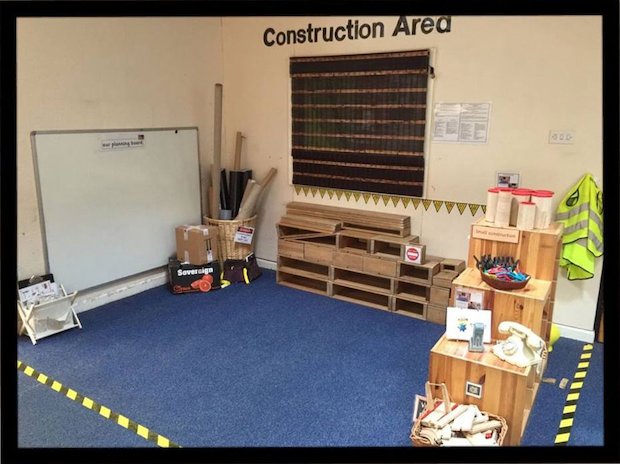What’s in your… construction area?
Add to My Folder
In this series, Fe Luton explores the ways in which you can set up and run areas of continuous provision. Ideas for organisation, resources and planning are explored.

Image: Early Years ideas from Tishylishy
How should my construction area be arranged?
Construction covers an array of ideas, experiences, equipment and resources and incorporates the use of construction kits, natural materials and the art of ‘junk modelling’. A construction area should enable children to explore, actively learn, create and think critically. Children should be able to develop their own ideas without adult support and should have a broad range of materials available for the development of these ideas.
Children will need to be shown certain techniques and approaches, but most of the resources that you provide should enable them to work independently. Construction offers a huge scope for writing, maths, engineering, creativity, language, motor skills, cooperation and collaboration. It is not about having the best (and often expensive) construction kits but is about having open-ended resources that lend themselves to a child’s imagination.
Consider the following when organising your construction area:
- Construction should vary in scale from the likes of LEGO right up to crates or boxes – ideas should not be limited by scale
- Don’t be frightened to use real resources with real purpose as well as construction kits
- Try to dress your construction area in a way that draws in those who would not normally be interested in the area. Support those who lack confidence or ideas by offering guidance and problem solving support or by pairing them with child ‘experts’ – you could have a list of class consultants that children could ask for help from
- Think of ways to support children who may struggle with ideas by creating your own open-ended construction dice: roll one to suggest what to make and another to suggest what to make it from. Alternatively, you could incorporate transportable challenge bags that contain resources to create something from – include a challenge card/image with ‘Can you make a…’ on it
- Make sure that you have a large floor area available as well as table tops
- Store labelled resources on open shelving so that children can see what is available. Try and have some of this shelf space available for completed or partially completed constructions – there is nothing worse than completing, or half completing, a structure to be told to take it apart
- Children will need space to work collaboratively, so try to position your construction area away from the more tranquil parts of your classroom
- The key for creativity is having a range of ‘open-ended’ resources that can be adapted for a range of imaginative purposes. Ask parents for resources – don’t be frightened to be specific and selective
- Don’t be too prescriptive, but offer inspiring ideas or provocations to support children in the development of their ideas and to ensure skill development
What resources should I have in my construction area?
- Construction kits – interlocking bricks like LEGO, construction kits including connectors, cogs and wheels, and screws and bolts
- Cardboard boxes and tubes – make sure that you have various sizes and shapes available, e.g. cereal boxes, egg cartons, juice cartons, shoe boxes, toothpaste boxes, tissue boxes, kitchen rolls, sweet tubes
- Paper – e.g. newspaper, wallpaper, crepe paper, sugar paper, corrugated paper, tissue paper, wrapping paper, paper plates
- Joining materials – make sure that you have a broad array of easily accessible and usable joining materials, e.g. masking tape, Sellotape, PVA glue, glue sticks, brown tape, split pins, treasury tags, pipe cleaners, Blu-Tack ®, Velcro, paper clips, elastic bands, bag twists, and clothes pegs
- Tools – have a wide range of tools available such as: scissors, hole punches (single), pliers, measuring equipment and modelling tools
- Junk materials and ‘add-ons’ or decorative materials – this is a fairly endless list – it might include: yoghurt cartons, a range of fabric pieces, lollipop sticks, polystyrene and plastic trays, wool, string, sequins, tin lids, plastic lids and tops, fabric, foil (sheets and pie dishes), buttons, ribbon, glitter, cork, pieces of carpet, packaging, buttons, shiny paper, cellophane
- Add on structures – old steering wheels or construction wheels that can be added to cardboard boxes
- Characters, scenery and props – include small-world people, cars, jungle creatures and farm animals, keys, large sheets or rolls of paper and pens
- Books, plans and photographs – these can inspire children to draw plans of their own. If possible include: architect plans, information books, ‘flat pack’ furniture plans, photographs of a range of constructions
- Recording materials – have available materials to record designs and draw models and include A4 plastic files for children to file their designs
- Evaluation sheets – children can use symbols to ‘read’ and complete
- Materials/equipment request forms – for children to request any additional things they want to use that are not immediately available
Already a member? Sign in below.
Published 8 February 2018
Reviews
You need to be signed in to place a review.